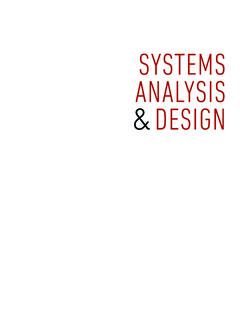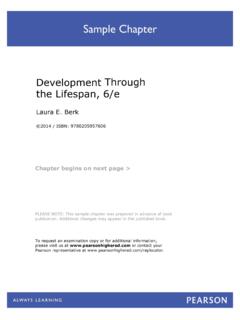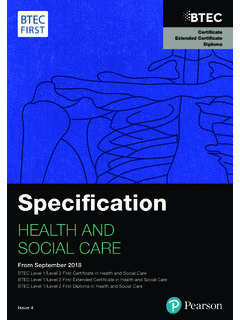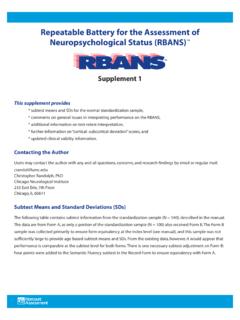Transcription of SEVENTH EDITION Using Multivariate Statistics - Pearson
1 SEVENTH EDITION . Using Multivariate Statistics Barbara G. Tabachnick California State University, Northridge Linda S. Fidell California State University, Northridge 330 Hudson Street, NY NY 10013. 1 5/17/18 8:59 PM. Portfolio Manager: Tanimaa Mehra Co mpositor: Integra Software Content Producer: Kani Kapoor Services Pvt. Ltd. Portfolio Manager Assistant: Anna Austin Printer/Binder: LSC Communications, Inc. Product Marketer: Jessica Quazza Cover Printer: Phoenix Color/Hagerstown Art/Designer: Integra Software Services Pvt. Ltd. Cover Design: Lumina Datamatics, Inc. Fu ll-Service Project Manager: Integra Software Cover Art: Shutterstock Services Pvt. Ltd. Acknowledgments of third party content appear on pages within the text, which constitutes an extension of this copyright page.
2 Copyright 2019, 2013, 2007 by Pearson Education, Inc. or its affiliates. All Rights Reserved. Printed in the United States of America. This publication is protected by copyright, and permission should be obtained from the publisher prior to any prohibited reproduction, storage in a retrieval system, or transmission in any form or by any means, electronic, mechanical, photocopying, recording, or otherwise. For information regarding permis- sions, request forms and the appropriate contacts within the Pearson Education Global Rights & Permissions department, please visit Pearson and ALWAYS LEARNING are exclusive trademarks owned by Pearson Education, Inc. or its affiliates, in the , and/or other countries.
3 Unless otherwise indicated herein, any third-party trademarks that may appear in this work are the property of their respective owners and any references to third-party trademarks, logos or other trade dress are for demon- strative or descriptive purposes only. Such references are not intended to imply any sponsorship, endorsement, authorization, or promotion of Pearson 's products by the owners of such marks, or any relationship between the owner and Pearson Education, Inc. or its affiliates, authors, licensees or distributors. Many of the designations by manufacturers and seller to distinguish their products are claimed as trademarks. Where those designations appear in this book, and the publisher was aware of a trademark claim, the designa- tions have been printed in initial caps or all caps.
4 Library of Congress Cataloging-in-Publication Data Names: Tabachnick, Barbara G., author. | Fidell, Linda S., author. Title: Using Multivariate Statistics /Barbara G. Tabachnick, California State University, Northridge, Linda S. Fidell, California State University, Northridge. Description: SEVENTH EDITION . | Boston: Pearson , [2019] | Chapter 14, by Jodie B. Ullman. Identifiers: LCCN 2017040173| ISBN 9780134790541 | ISBN 0134790545. Subjects: LCSH: Multivariate analysis. | Statistics . Classification: LCC QA278 .T3 2019 | DDC dc23. LC record available at 1 18. Books a la Carte ISBN-10: 0-13-479054-5. ISBN-13: 978-0-13-479054-1. 2 5/17/18 8:59 PM. Contents Preface xiv Prediction of Group Membership 20.
5 One-Way Discriminant Analysis 20. 1 Introduction 1 Sequential One-Way Discriminant Analysis 20. Multivariate Statistics : Why? 1 Multiway Frequency Analysis The Domain of Multivariate Statistics : (Logit) 21. Numbers of IVs and DVs 2 Logistic Regression 21. Experimental and Nonexperimental Sequential Logistic Regression 21. Research 2 Factorial Discriminant Analysis 21. Computers and Multivariate Statistics 3 Sequential Factorial Discriminant Garbage In, Roses Out? 4 Analysis 22. Some Useful Definitions 5 Structure 22. Principal Components 22. Continuous, Discrete, and Dichotomous Data 5 Factor Analysis 22. Structural Equation Modeling 22. Samples and Populations 6. Time Course of Events 22.
6 Descriptive and Inferential Statistics 7. Survival/Failure Analysis 23. Orthogonality: Standard and Sequential Time-Series Analysis 23. Analyses 7. Some Further Comparisons 23. Linear Combinations of Variables 9. A Decision Tree 24. Number and Nature of Variables to Include 10. Technique Chapters 27. Statistical Power 10. Preliminary Check of the Data 28. Data Appropriate for Multivariate Statistics 11. The Data Matrix . The Correlation Matrix . 11. 12. 3 Review of Univariate and The Variance Covariance Matrix 12. Bivariate Statistics 29. The Sum-of-Squares and Cross-Products Hypothesis Testing 29. Matrix 13 One-Sample z Test as Prototype 30. Residuals 14 Power 32. Organization of the Book 14 Extensions of the Model 32.
7 2. Controversy Surrounding Significance A Guide to Statistical Techniques: Testing 33. Using the Book 15 Analysis of Variance 33. Research Questions and Associated Techniques 15 One-Way Between-Subjects ANOVA 34. Degree of Relationship Among Variables 15 Factorial Between-Subjects ANOVA 36. Bivariate r 16 Within-Subjects ANOVA 38. Multiple R 16 Mixed Between-Within-Subjects ANOVA 40. Sequential R 16 Design Complexity 41. Canonical R 16 Nesting 41. Multiway Frequency Analysis 17 Latin-Square Designs 42. Multilevel Modeling 17 Unequal n and Nonorthogonality 42. Significance of Group Differences 17 Fixed and Random Effects 43. One-Way ANOVA and t Test 17 Specific Comparisons 43.
8 One-Way ANCOVA 17 Weighting Coefficients for Factorial ANOVA 18 Comparisons 43. Factorial ANCOVA 18 Orthogonality of Weighting Coefficients 44. Hotelling's T 2 18. Obtained F for Comparisons 44. One-Way MANOVA 18. Critical F for Planned Comparisons 45. One-Way MANCOVA 19. Critical F for Post Hoc Comparisons 45. Factorial MANOVA 19. Factorial MANCOVA 19 Parameter Estimation 46. Profile Analysis of Repeated Measures 19 Effect Size 47. iii 3 5/17/18 8:59 PM. iv Contents Bivariate Statistics : Correlation and Regression 48. Correlation 48. 5 Multiple Regression 99. Regression 49 General Purpose and Description 99. Chi-Square Analysis 50 Kinds of Research Questions 101. Degree of Relationship 101.
9 4 Cleaning Up Your Act: Screening Importance of IVs 102. Data Prior to Analysis 52 Adding IVs 102. Important Issues in Data Screening 53 Changing IVs 102. Accuracy of Data File 53 Contingencies Among IVs 102. Honest Correlations 53 Comparing Sets of IVs 102. Inflated Correlation 53 Predicting DV Scores Deflated Correlation 53 for Members of a New Sample 103. Missing Data 54 Parameter Estimates 103. Deleting Cases or Variables 57 Limitations to Regression Analyses 103. Estimating Missing Data 57 Theoretical Issues 103. Using a Missing Data Correlation Practical Issues 104. Matrix 61 Ratio of Cases to IVs 105. Treating Missing Data as Data 61 Absence of Outliers Among Repeating Analyses with and without the IVs and on the DV 105.
10 Missing Data 61 Absence of Multicollinearity and Choosing Among Methods for Singularity 106. Dealing with Missing Data 62 Normality, Linearity, and Outliers 62 Homoscedasticity of Residuals 106. Detecting Univariate and Independence of Errors 108. Multivariate Outliers 63 Absence of Outliers in the Solution 109. Describing Outliers 66 Fundamental Equations for Multiple Reducing the Influence Regression 109. of Outliers 66. General Linear Equations 110. Outliers in a Solution 67. Matrix Equations 111. Normality, Linearity, and Homoscedasticity 67 Computer Analyses of Small-Sample Normality 68. Example 113. Linearity 72 Major Types of Multiple Regression 115. Homoscedasticity, Homogeneity Standard Multiple Regression 115.














